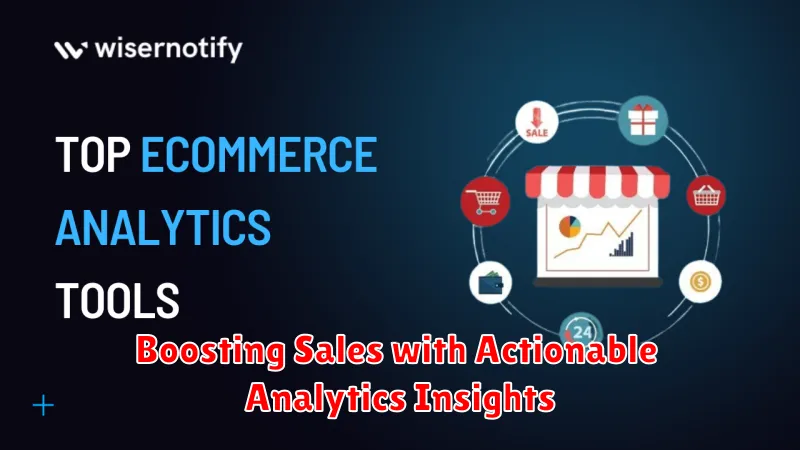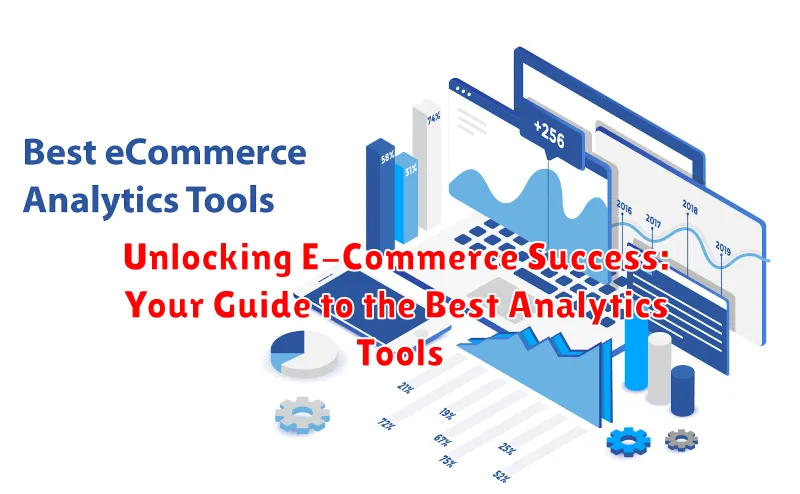In today’s fiercely competitive digital landscape, e-commerce success hinges on data-driven decision-making. Understanding your customers, optimizing your website, and refining your marketing strategies requires a deep dive into the wealth of information generated by your online store. This is where the power of e-commerce analytics tools comes into play. These essential tools provide invaluable insights into every aspect of your online business, from customer behavior and sales trends to marketing ROI and inventory management. Unlocking this potential is the key to staying ahead of the curve and achieving sustainable e-commerce growth. This comprehensive guide will equip you with the knowledge to select the best analytics tools tailored to your specific business needs.
Choosing the right e-commerce analytics tools can be overwhelming, given the sheer number of options available. This guide will delve into the features, benefits, and pricing of the best analytics platforms on the market, enabling you to make an informed decision. We’ll explore the crucial metrics you should be tracking, from conversion rates and average order value to customer lifetime value and churn rate. By leveraging the power of these analytics tools, you’ll gain a competitive edge, enhance your customer experience, and ultimately, unlock your e-commerce success.
Understanding the Importance of E-Commerce Analytics
In today’s competitive digital landscape, leveraging e-commerce analytics is no longer a luxury, but a necessity. Understanding your customers’ behavior, preferences, and purchasing patterns is crucial for driving sales and achieving sustainable growth. E-commerce analytics empowers businesses to make data-driven decisions, optimize their online stores, and enhance the overall customer experience.
With access to comprehensive data, you can identify key performance indicators (KPIs) such as conversion rates, average order value, and customer lifetime value. Analyzing these metrics allows you to pinpoint areas for improvement, personalize marketing campaigns, and ultimately, boost your bottom line.
Effective e-commerce analytics provides valuable insights into:
- Customer behavior: Understand how customers interact with your website, what products they view, and where they abandon their carts.
- Marketing effectiveness: Track the success of your marketing campaigns and identify which channels are driving the most valuable traffic.
- Sales performance: Monitor sales trends, identify top-selling products, and optimize pricing strategies.
- Website optimization: Improve website navigation, user experience, and checkout processes to increase conversions.
Key Features to Look for in an Analytics Tool
Choosing the right e-commerce analytics tool is crucial for data-driven decision making. Look for key features that align with your business needs. Real-time reporting provides up-to-the-minute data on website traffic and sales. Customizable dashboards allow you to visualize key metrics relevant to your goals. Segmentation capabilities enable analyzing customer behavior based on demographics, purchase history, and other factors.
Conversion tracking is essential to understanding which marketing campaigns and website elements are driving sales. Product performance analysis helps identify top sellers and underperforming products. Integration with other platforms, such as your e-commerce platform and marketing automation software, streamlines data collection and analysis.
Finally, consider the reporting features. Ensure the tool can generate comprehensive reports that can be easily shared with stakeholders. Look for options to export data in various formats for further analysis.
Top Free E-Commerce Analytics Tools

Leveraging free analytics tools can provide valuable insights into your e-commerce performance without impacting your budget. Here are a few popular choices:
Google Analytics
Google Analytics remains a cornerstone of website analytics. Its free version offers extensive data on traffic sources, user behavior, and conversions, making it a powerful tool for understanding your online store’s performance. While the interface can be complex, the depth of information is invaluable.
Basic E-commerce Platform Analytics
Most e-commerce platforms include built-in analytics dashboards. Platforms like Shopify, WooCommerce, and Squarespace offer basic metrics on sales, orders, and customer demographics. These dashboards are a convenient starting point for understanding your store’s key performance indicators (KPIs).
Exploring Premium E-Commerce Analytics Platforms
While free tools offer a valuable starting point, premium e-commerce analytics platforms provide advanced features and deeper insights for scaling businesses. These platforms often come with a subscription fee but offer a comprehensive suite of tools to drive strategic decision-making.
Key benefits of premium platforms often include advanced segmentation capabilities, predictive analytics, real-time reporting, and custom dashboards. They can also integrate with a wider range of data sources, like CRM and marketing automation systems, providing a holistic view of customer behavior.
Examples of Popular Premium Platforms:
- Platform A: Known for its robust attribution modeling and in-depth customer journey analysis.
- Platform B: Offers advanced cohort analysis and predictive modeling for forecasting sales and identifying trends.
- Platform C: Specializes in real-time data visualization and personalized reporting dashboards.
Choosing the right platform depends on your specific needs and budget. Consider factors such as the size of your business, the complexity of your data, and the level of support required.
Integrating Analytics with Your E-Commerce Strategy
Effectively integrating analytics is crucial for maximizing the value of your data. It’s not enough to simply collect information; you must actively use it to inform your decisions.
Start by defining clear objectives. What do you want to achieve with your e-commerce business? Increased sales? Improved customer retention? Higher average order value? Your analytics strategy must align with these goals.
Next, establish key performance indicators (KPIs) that directly reflect your objectives. Track metrics like conversion rates, bounce rates, and customer lifetime value. Regularly monitor these KPIs to gauge the effectiveness of your strategies.
Data-driven decision making is the cornerstone of successful e-commerce. Use the insights gleaned from your analytics to optimize product listings, personalize marketing campaigns, and refine your overall business strategy.
Finally, foster a culture of data literacy within your organization. Ensure that your team understands how to interpret and utilize data effectively. This will empower them to make informed decisions that drive business growth.
Leveraging Data to Improve Customer Experience
In the competitive e-commerce landscape, understanding your customer is paramount. Data analytics provides the key to unlocking valuable insights into customer behavior, allowing businesses to tailor their strategies for enhanced customer experiences.
By analyzing website traffic, businesses can identify popular products and preferred navigation paths. This data enables strategic placement of products and streamlined website navigation, making it easier for customers to find what they need.
Analyzing purchase history reveals customer preferences and buying patterns. This information allows for personalized product recommendations and targeted marketing campaigns, increasing customer engagement and conversion rates.
Furthermore, analyzing customer feedback through surveys and reviews provides invaluable insights into areas for improvement. Addressing these pain points can lead to increased customer satisfaction and loyalty. Proactive customer service, driven by data, can address issues before they escalate, further enhancing the customer experience.
Boosting Sales with Actionable Analytics Insights

Data analytics offers a powerful arsenal for boosting e-commerce sales. By analyzing key metrics, businesses can identify areas for improvement and implement targeted strategies to drive conversions.
Product Performance Analysis helps pinpoint top-selling items and identify underperforming products. This data informs inventory management, pricing adjustments, and product development decisions.
Understanding customer behavior is crucial. Analytics tools track customer journeys, revealing where customers drop off in the sales funnel. This insight allows for optimization of the checkout process, targeted advertising campaigns, and personalized product recommendations.
Analyzing marketing campaign effectiveness is essential for maximizing ROI. By tracking key metrics like click-through rates and conversion rates, businesses can optimize their campaigns for better results. A/B testing different ad creatives and landing pages provides valuable data for making informed decisions about marketing spend.
Measuring the ROI of Your Analytics Investment
Investing in e-commerce analytics is a strategic move, but demonstrating its return on investment (ROI) is crucial. Quantifying the impact of your analytics tools allows you to justify the expense and refine your strategies for optimal performance.
Start by establishing clear key performance indicators (KPIs) aligned with your business goals. Examples include conversion rates, average order value, and customer lifetime value. Track these metrics before and after implementing your analytics tools to measure the direct impact.
Calculate the cost of your analytics investment, encompassing software licenses, implementation fees, and ongoing maintenance. Compare this cost against the financial gains driven by data-informed decisions. For example, if your analytics insights lead to a 10% increase in conversions, calculate the monetary value of that increase and compare it to your investment cost.
Beyond direct financial gains, consider qualitative benefits. These may include improved customer satisfaction, streamlined operations, and enhanced marketing campaign effectiveness. While harder to quantify, these benefits contribute significantly to long-term success.

